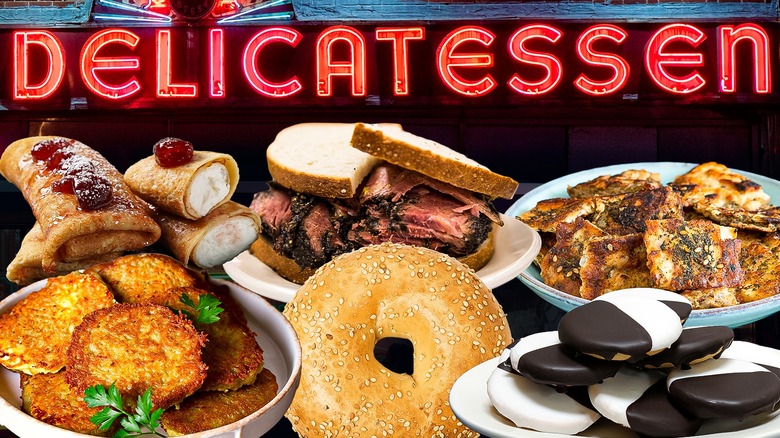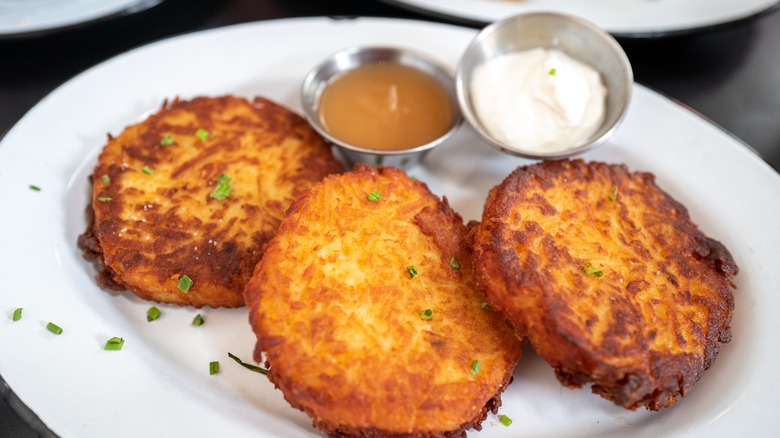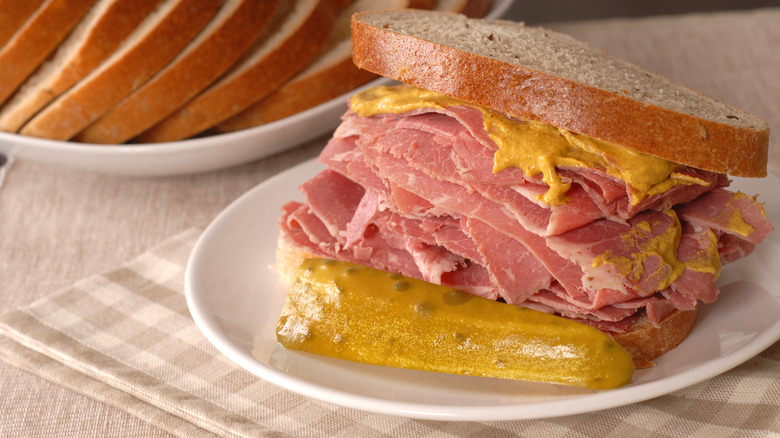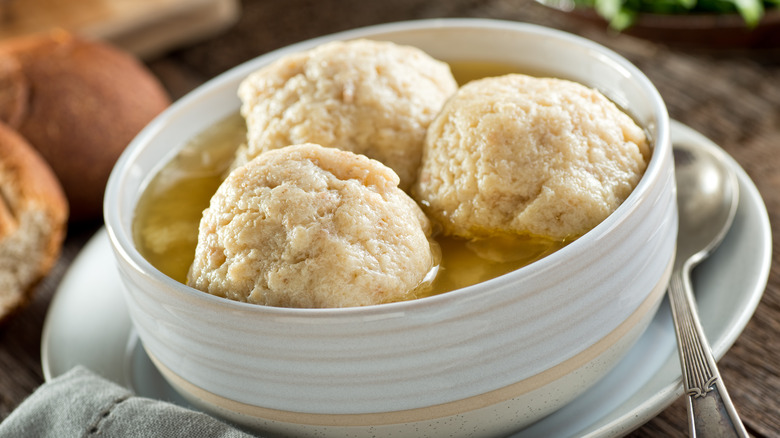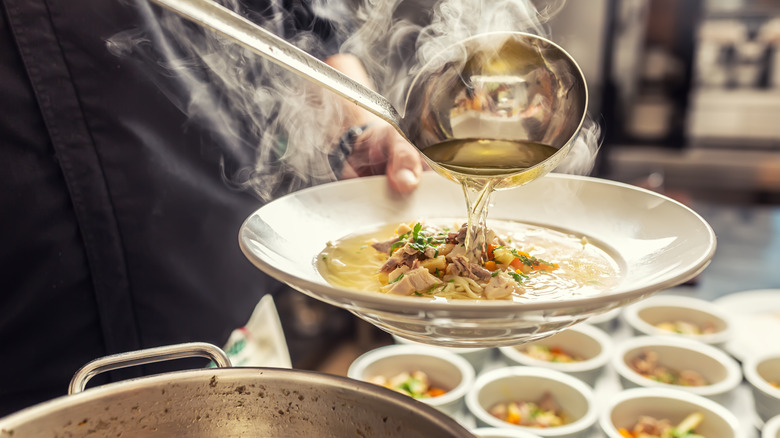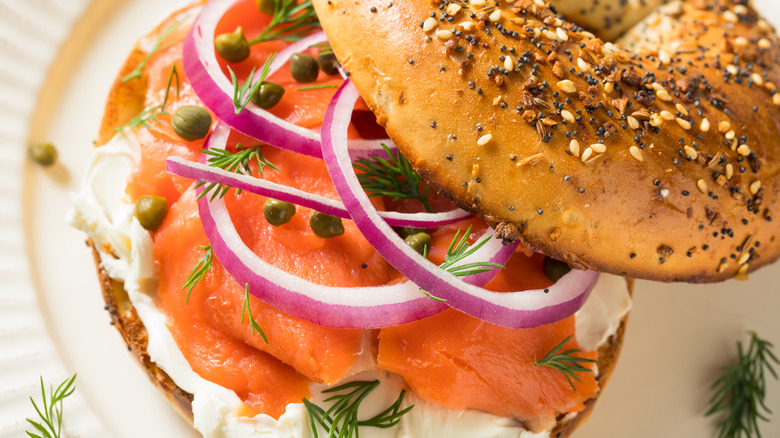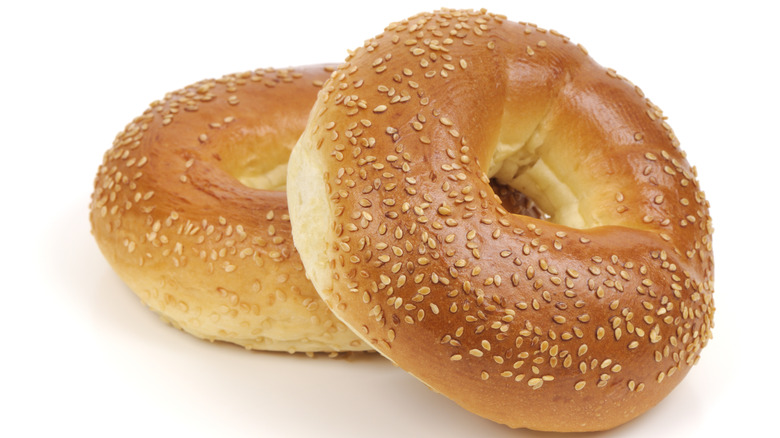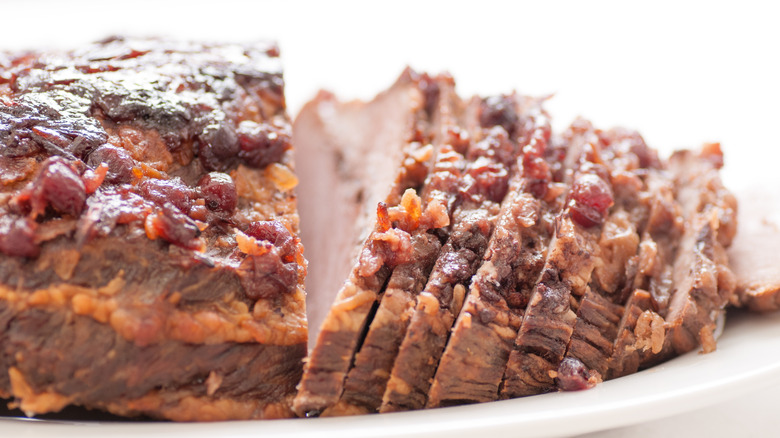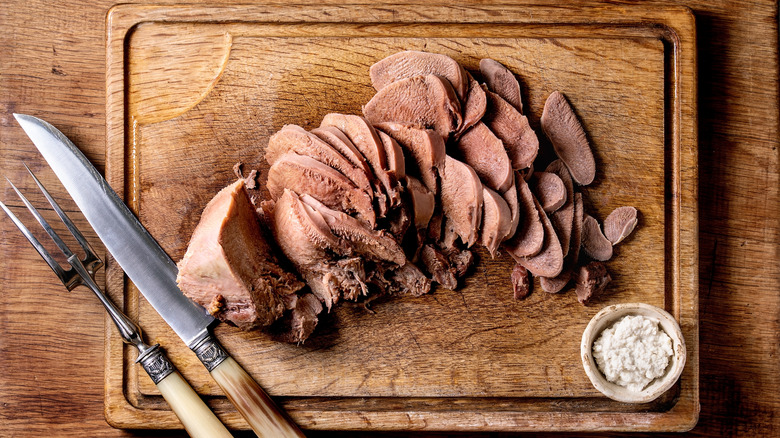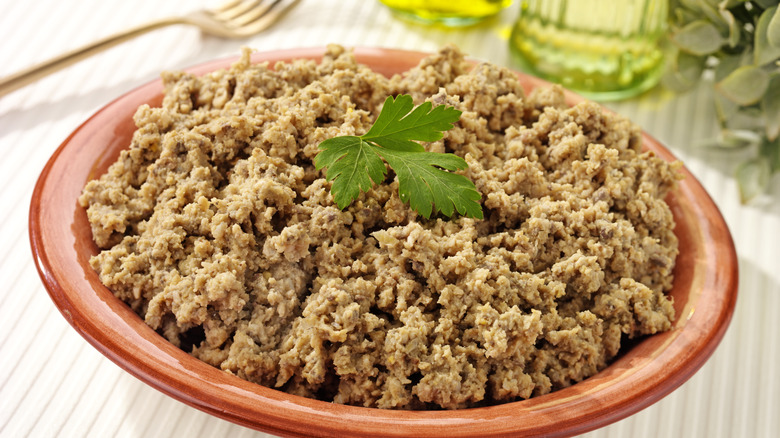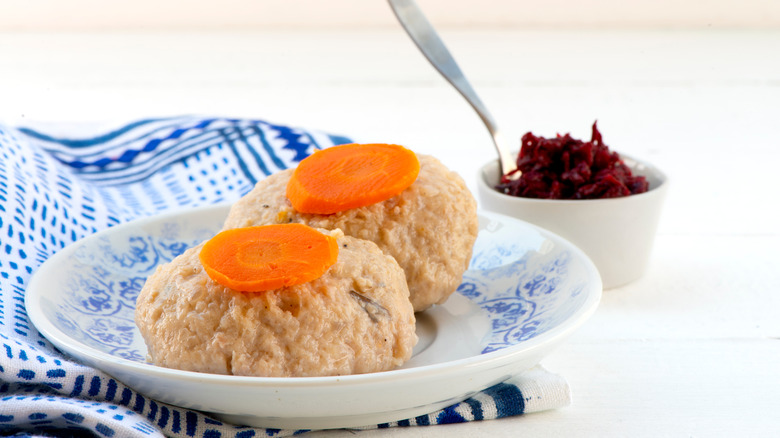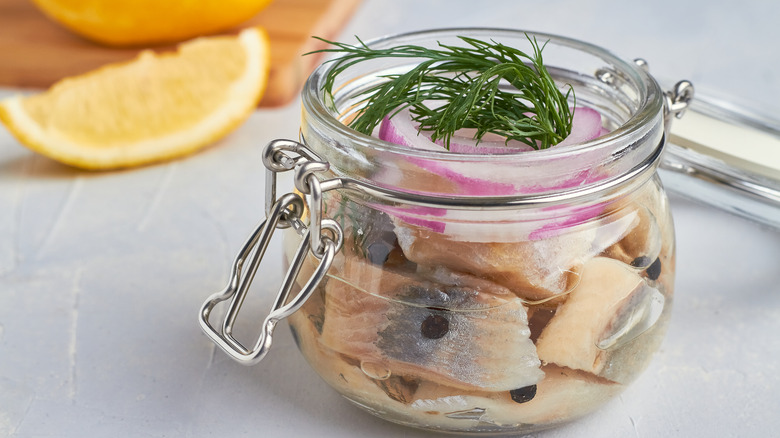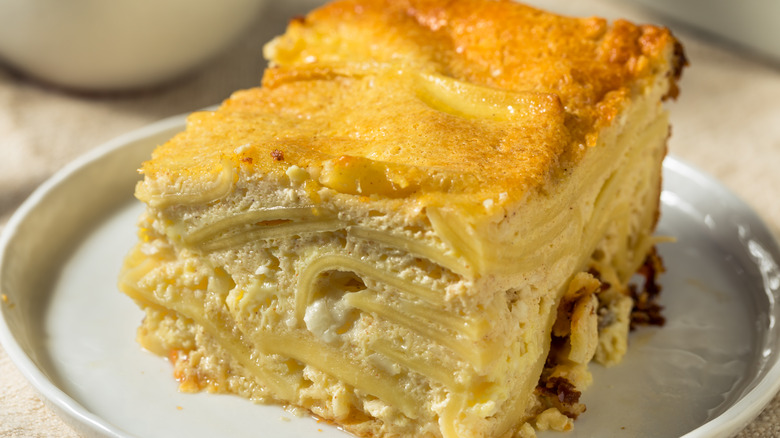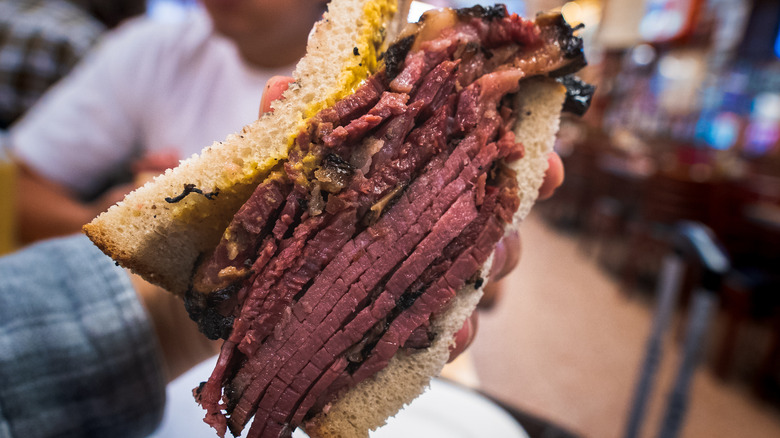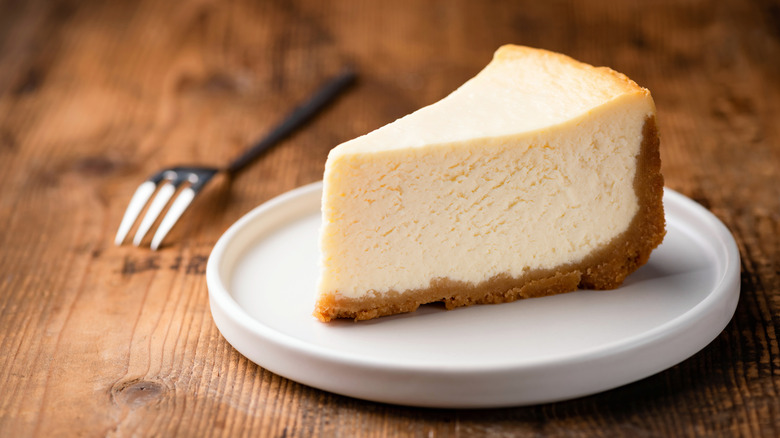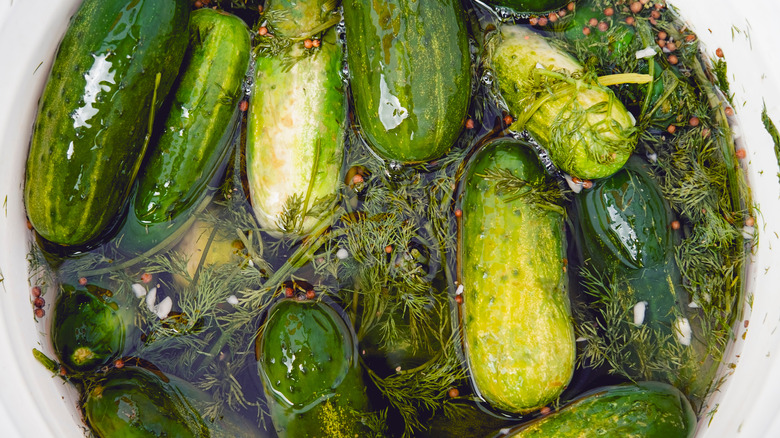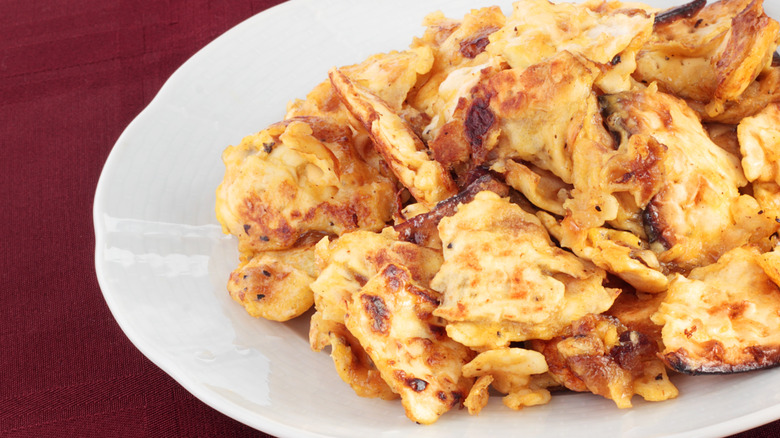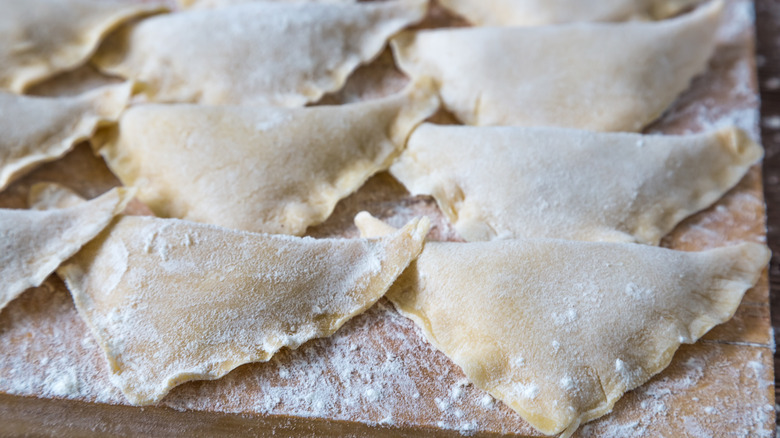20 Foods You'll Commonly Find At A Jewish Deli
As the late Jonathan Gold once said, "The deli is where you go to be Jewish." Jewish delicatessens in America are an institution and a living testament to the history of Eastern European Ashkenazi communities who immigrated primarily to escape religious persecution and genocide, making the U.S. their home and adapting their foods to suit a new life and available resources.
While the fixtures of the Jewish deli are changing to accommodate tastes, other cultural influences, customer demands, and resources, there are some classics you can count on being present. They're like part of the furniture, even if only to inspire other dishes to come from them. These popular items were once considered innovative in their own time, leading us to believe the future is still bright for the Jewish deli. Here are some popular, crowd-pleasing dishes you're bound to find on your next visit to your local Jewish deli.
Latkes
What isn't there to love about a deep-fried crispy latke? Traditionally made in celebration of Hanukkah, the Jewish festival of lights, latkes can be found at the Jewish deli year-round. Interestingly, though the dish is now associated with shredded potatoes as its base, history points to ricotta cheese as the original ingredient, inspired by Italian iterations.
Latkes are a welcome treat no matter what time of year. We'd happily eat a stack that's been freshly fried and served simply alongside sour cream and apple sauce for dipping and slathering. Popular, too, are a more indulgent version; many delis will use the crispy potato pancakes as a substitute for bread, filling them with lashings of thinly sliced corned beef for the ultimate treat. Philly-based Hymie's takes the trend above and beyond with a special latke Reuben on its menu.
Blintzes
The origins of blintzes, a decedent rolled crepe found in Ashkenazi cuisine, are a bit murky. Though it isn't a complete certainty, they most likely originated in Hungary. Like many other Ashkenazi dishes, Blintzes can be commonly found in many Jewish-style delis across the U.S.
For those who've never had the pleasure of partaking, blitzes are the French crepe's slightly thicker-skinned Jewish cousin. Where crepes can be filled with either sweet or savory ingredients, blitzes on the deli menu are primarily sweet, with either a sweet farmer's cheese or cheese and fruit filling wrapped in a wheat-based pastry browned in butter and topped with berries and sour cream. Blintzes, alongside other dairy-based treats like cheesecake, are a customary part of the springtime celebration of Shavuot.
Corned beef on rye
What would a Jewish deli be without that ubiquitous salty, smoky, mouth-watering smell of corned beef wafting through the air? Corned beef on rye is a deli order that's as timeless as a little black dress or pearls.
Its name comes from the curing process; its Latin root references something seed-like in size, like the salt used to create its deeply savory, rich flavor that also preserves the meat. Beef curing became a technique perfected by the Irish. Fans of corned beef owe thanks to the combined efforts of Irish and Jewish immigrants of the mid 1800s, who, out of necessity and shared interest, combined the curing process from the Irish and the cuts of the brisket by Jewish butchers to create a product loved by many.
Matzoh ball soup
You never need an excuse, a holiday, or a heartbreak to justify tucking into a bowl of comforting matzoh ball soup. The dish, however, is a beloved part of the ritualized eating ceremony known as the Passover seder; the holiday commemorates the exodus of the Jewish people from enslavement in Egypt through storytelling and eating rituals.
Traditionally made from matzoh meal, eggs, and schmaltz (or chicken fat) to form round dumplings called knoedel (German), knoedela (Polish), kneidlach (Yiddish), or matzoh balls that come bobbing in a bowl of rich golden-hued broth. Though there's a bit of a debate as to texture preference, fluffy versus dense (we're team fluffy), there's a ball for everyone waiting for your coast to coast, from Katz's to Langer's to Larder and everywhere in between.
Chicken noodle soup
Feeling under the weather is a great excuse to your local Jewish deli for a piping hot bowl of Jewish penicillin — chicken noodle soup. Not just a cultural comfort food, or something Mom might have made in an attempt to ease a sick child, chicken soup has a long-standing history across many cultures as a cure-all for ailments from asthma to leprosy. There is also a certain amount of science-backed evidence which suggests that chicken releases mild anti-inflammatory properties when cooked and can help to heal upper respiratory tract infections.
Science aside, chicken noodle soup is a mainstay on most Jewish deli menus, loved by all ages, from the very young to the very old. Catering to all ages to create a family-friendly atmosphere is what the deli is all about.
Smoked white fish
When it comes to terminology in the Jewish deli, whitefish has become somewhat of a catch-all term for the varieties of smoked or cured freshwater fish. The fish is cured, often smoked, and served cold and alongside bagels and cream cheese. These kinds of foods are also referred to as "appetizing," meaning that they fall under the fish and milk category rather than meat, as the two must be separated according to Kosher law.
Unlike the Kosher-style delis that have become most prevalent and offer both fish and meat, Jewish eateries serving highly religious communities need to specialize in either appetizing or delicatessens, but not both, in order to adhere to Kosher law. A popular example that manages to cross cultural lines while still upholding kosher laws is Russ & Daughters, which specializes in appetizing including smoked white fish, cured salmon, pickled herring, and more.
Lox
Nothing quite says brunch at the local Jewish deli like a chewy mishmash bagel, a thick schmear of cream cheese, and a scattering of capers and red onion, all of which sit under a silk sheet of perfectly pink lox or cured salmon. The tradition of cold, freshwater fish curing is present across many cultures, including Scandinavia and Slovic communities. Salt curing, now used primarily to create flavor, was also used around the globe to preserve a variety of perishable food items, from vegetables to meat to fish.
Derived from the Yiddish word "laks," which means salmon, lox is a cured fish that should not be confused with the process of smoking salmon. Smoking is a multi-step process that can include a broader range of cuts of fish than traditional lox, whereas lox is simply salt-cured and left unsmoked.
Bagels
If you are reading this article, you are likely already very familiar with what a quality bagel looks like. The trick to creating the perfect bagel comes from the multi-step process of treating the dough by first boiling and then baking the product, creating a textural wonderland of chewy-meets-crusty in the process.
This much-loved food item used to be carted around the New York City streets, in particular the Lower East Side, on pieces of string or poles (and, yes, there is a difference between beigels and bagels). This method of carry makes good sense when considering the name 'bagel' has morphed over time from the Yiddish word beygl, meaning bracelet or ring, becoming beigel, to its current form. There are numerous flavors from which to choose, including poppyseed, onion, mishmosh (everything) sesame, salt, and cinnamon raisin, to name just a few.
Brisket
You can't go wrong with an order of slow-cooked brisket at the deli. It's often found in multiple ways and forms on the menu, including pulled barbecued brisket sandwiches served hot with a side of noodle kugel or mashed potatoes.
Known for being a tough cut of meat, the key to cooking brisket is time. This cut of beef is a workhorse; it's a muscle that supports much of the animal's weight, located just under the cow's ribs, along the torso. This is why it can be notoriously tough if not cooked well.
It is the cut's challenging characteristic that made it an affordable option for Jewish immigrants, who, by using a low and slow cooking process, turned what was considered undesirable peasant food into a delicious meal. You can also find brisket making appearances in other areas outside the Jewish deli, like Jewish barbecue joints, as it absorbs techniques like smoking incredibly well.
Tongue
Tongue, considered offal or organ meat, is embraced by a variety of communities, from Jewish immigrants in New York City to communities across Mexico. They have separately taken an undesirable and challenging part of the cow and turned it into a cultural and culinary staple that displays so perfectly the idea of waste-free cooking, even if out of necessity.
Cooking a tongue is a time-consuming and laborious task, as several layers must first be removed, often through boiling. The meat is then braised to make it soft and succulent. Tongue often comes pickled or cured, served in a sandwich. Katz's Delicatessen in New York City serves two different cuts: center and tip, cold between two slices of bread of your choice. Others like Langer's offer a hot option, as well. No matter how you slice it, the tongue is a labor of love and a classic deli item.
Chopped liver
When we hear the phrase "What am I, chopped liver?" we understand chopped liver is being likened to something overlooked or of little value. Though its popularity within the Ashkenazi community may be on the decline, chopped liver is still considered a valuable cultural staple and one you will undoubtedly still find on the deli menu.
Made from chicken livers, schmaltz, and browned onions, this dish originated from Jewish communities in France who used goose rather than chicken, likely as an alternative to pâté, before making its way into other Jewish communities across Europe. Like many options at the deli, you can purchase chopped liver by the pound to take it home, or you can choose instead to have it on site. Folks at The General Muir serve it alongside toasted pretzel bread or on a pastrami sandwich. However you choose to enjoy it, chopped liver is nothing to sneer at.
Gefilte fish
While most people associate gefilte fish with Jewish holidays like Passover, it can and should be eaten year-round. The name means "stuffed" in Yiddish, referring to the whole fish stuffed with a mixture of fish, carrots, onions, and spices before being baked. Today, the whole fish is absent from the recipe, and the stuffing mixture now makes up the dish, traditionally served alongside grated horseradish, picked beetroot, or chrain (which is a combination of the two).
Though gefilte fish was first popularized by the Catholic rather than the Jewish community as the perfect dish for Lent, it has undoubtedly created a home for itself at the Jewish deli and dinner table. Delis around the country, like Larder in Cleveland, Zingerman's in Ann Arbor, and Wexler's in Los Angeles, are making their own versions of it.
Herring
The roots of salting freshwater fish like herring began with the Dutch in the 1400s, who salted the fish before exporting them to Europe for preservation's sake. Picked up by Jewish merchants who became the predominant herring traders of Europe, it soon seeped into the Jewish cultures of Easter Europe, adapted to include traditional and readily available ingredients, which helped to increase the fish's appeal, as herring was associated mainly with poverty and lower classes. As Eastern European Jewish communities made their way to the U.S., so, too, did the herring, now associated with the diaspora.
Today, herring comes in all shapes and varieties, from pickled to chopped to creamed. It is primarily associated with the Ashkenazi community and readily available alongside a variety of smoked fish as part of an appetizing menu (to mean fish or milk, but not meat, in line with Kosher dietary laws).
Kugel
Browse any list of side dishes on any Jewish deli's menu, and you are likely to spot at least one (if not several), types of kugel offered, including potato, vegetable, and lokshen (meaning noodle). Depending on the ingredients, different varieties of kugel will feature different flavors. For instance, though savory examples do exist, noodle kugels tend to favor sweet ingredients through their usage of fruits like raisins or pineapple alongside a binding of dairy and eggs. Potato and other vegetable-based kugels, however, tend to feature more savory flavors.
Kugels are another perfect example of how food travels alongside cultures, with lokshen kugel being adapted by Jewish communities traveling through Italy and parts of Asia and onto the U.S., leaving some foods behind and picking up others along the way. No matter what kind of kugel is on offer, you can never go wrong by ordering it.
Pastrami on rye
The peppercorn-laced smoked and cured meat we've come to know as pastrami is a unique and ubiquitous American Jewish deli feature. Making its way to New York City via Romanian immigrants in the late 1800s to be eventually piled onto caraway studded rye bread and served at the Jewish deli, it has a long and shared history with salt curing in the name of preservation, dating back to the Ottoman Empire.
While pastrami is a classic sandwich-filling option at most Jewish delis stateside, it's not necessarily the case outside the confines of U.S. borders as it is a unique expression of the American Ashkenazi Jewish diaspora rather than a universal Jewish food. So, if you find yourself stateside, there is no better reason to load up on the good stuff, including innovative delis like Mort & Betty's, offering vegan alternatives like the mushroom pastrami, showcasing the adaptability of the cuisine to suit modern tastes.
Cheesecake
The Jewish deli is a place of optimism. How do we know? Just glancing at the dessert menu points to copious amounts of hope that diners will somehow have the appetite to manage an overstuffed sandwich or piled-high bagel and still have room for dessert. If that isn't an example of optimism at its finest, we don't know what is.
That said, there is nothing quite like the siren call of a wedge of freshly baked New York-style cheesecake. Once known to have been the food of athletes at the first Olympic Games in 776 B.C.E., the pastry is fortified with copious amounts of dairy, perfect for celebrating Shavuot. Though cheesecake seems more likely to induce a Netflix marathon than the running kind, we'd happily entertain any excuse to order it.
Kosher dill pickles
Nothing says Jewish deli like having a plate filled with complimentary pickles dropped off at the table the moment you sit down or having a spear of half-done sour tucked into the paper of your perfectly wrapped corned beef sandwich. Pickles are the key to slicing through the salt-cured, gloriously meaty, fat-laced meats or stodgy potatoes that often feature on Ashkenazi menus, leaving your palate refreshed, balanced, and ready for more. Now a deli staple, they were once sold out of their picking barrels via pushcarts by Jewish merchants.
Far from exclusive to Jewish cuisines, pickles play an enormous and vital role in many cuisines around the globe due to their ability to preserve fresh ingredients to stretch outcrops and reserves through barren winter months. They are also known for their immune-supporting microbes when fermented or pickled without vinegar.
Black and white cookie
You'd be hard-pressed to turn up at any Jewish deli or bakery in New York City, and across the U.S. for that matter, and not rest your eyes upon the two-toned black and white cookie, incorporating two of the most popular flavors: chocolate and vanilla. The black and white cookie was first recorded as a product of Glaser's Bake Shop as early as 1902, now known for its cake-like base and shiny frosting.
Though now a part of popular culture, with the black and white featuring in Seinfeld alongside other New York institutions and Jewish bakery classics like babka, black and whites are by and largely unique to the American Jewish deli and bakery experience. There is much less expectation of finding them lining the shelves of the bakery case in other Jewish establishments around the world.
Matzoh brei
For anyone with a craving for matzoh brei outside of the eight days of Passover, all you have to do is head over to your local Jewish deli. It's most likely on the menu, right next to or under French toast (made with challah, of course), and other brunch classics like scrambled eggs with lox.
Sheets of matzoh (the flatbed eaten during Passover) are briefly soaked in egg, then fried and topped with either sweet or savory ingredients like maple syrup, a dusting of cinnamon and sugar, or savory ingredients like sautéed mushrooms and onions. Hymies in Merion, Pennsylvania, offers customers a choice between having their matzoh brei "scrambled" or "pancake style" to accommodate both sweet and savoy-leaning palates, further showcasing that matzoh brei isn't just for Passover, but for life.
Kreplach
Dumpling devotees of all kinds should remember the word "kreplach" for their next visit to the Jewish deli. Though perhaps one of the lesser-known items amongst non-Jewish communities, kreplach is a labor of love that showcases a slightly thicker than the wonton-style outer casing and a mixture of ground beef or chicken and sautéed onion filling. Once filled and closed, the dumplings are boiled in soup or deep-fried until crispy.
Like other dishes which require a significant amount of work, kreplach is often reserved for special occasions and holidays, like Yom Kippur, as part of the breakfast meal. However, for those who want to eat kreplach but don't want to spend hours hunched over the kitchen counter rolling, filling, and folding the dough, a trip to the Jewish deli is in order. This dark horse order is one of the most underrated and, frankly, one of our favorites when seeking out the taste of homemade comfort foods.
Static Media owns and operates Tasting Table and The Daily Meal.
